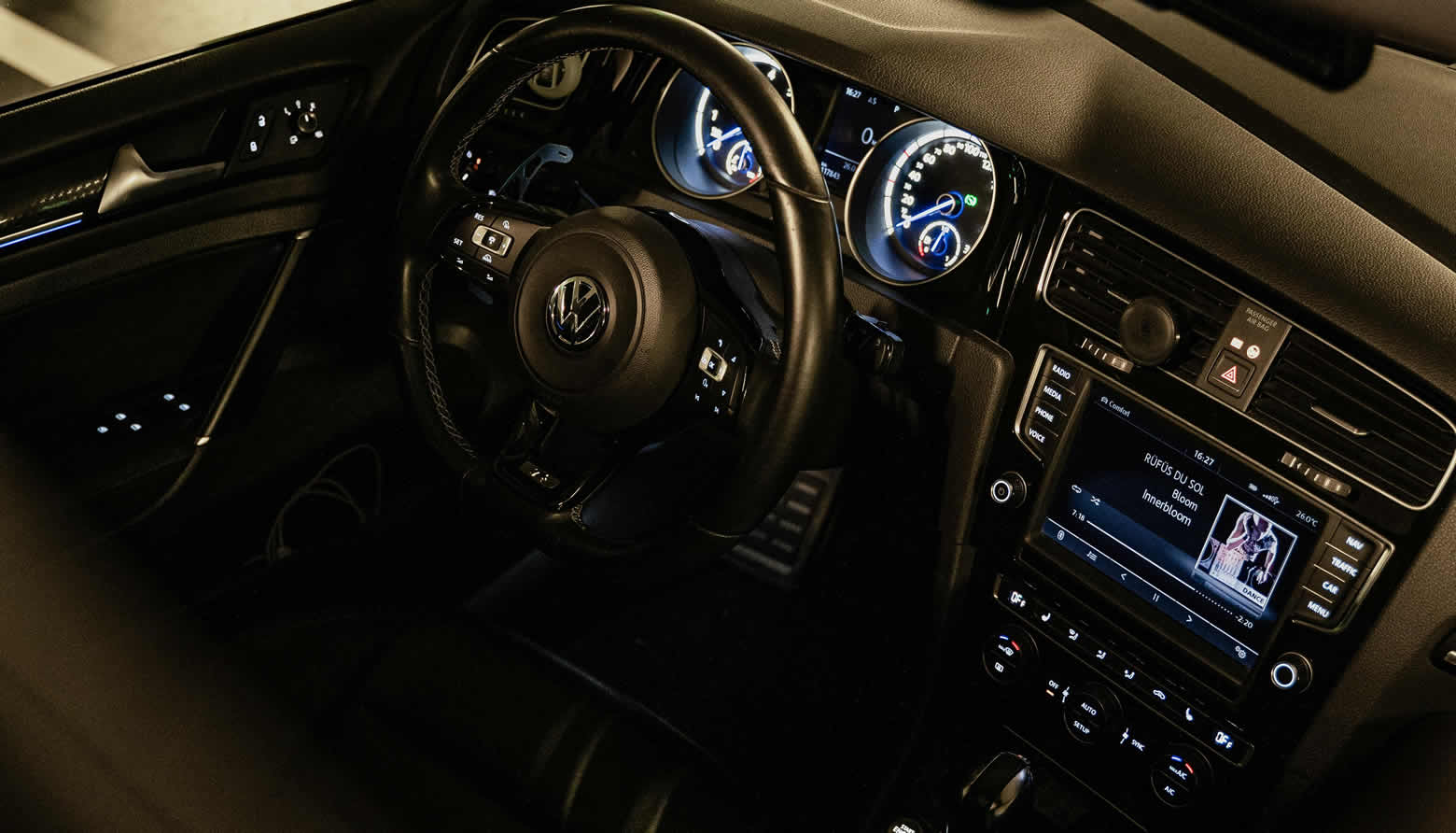When Volkswagen introduced the Golf 7.5, it wasn’t just a mid-cycle facelift. It was a carefully refined evolution that sharpened the car’s exterior styling, introduced cutting-edge lighting technologies, and optimized aerodynamics for efficiency and performance. While the Golf has always been recognized for its understated yet elegant design, the 7.5 version elevated the formula to a new level, delivering a modern, premium look that still carried the timeless DNA of the world’s most iconic hatchback. Complementing its exterior sophistication are interior enhancements such as the Digital Touch Climate Control For Golf 7/7.5, ensuring the Golf remains as advanced inside as it is outside.
The exterior styling of the Golf 7.5 builds upon the solid foundation of the seventh generation. At first glance, the changes may seem subtle, but they contribute to a more dynamic and contemporary impression. The front fascia received slimmer, more angular headlights, redesigned LED daytime running lights, and a revised bumper that improves airflow. The rear benefits from reshaped taillights with advanced LED signatures, giving the hatchback a sharper night-time identity. These styling updates harmonize with interior refinements such as the Digital Climate Control for Golf 7, proving Volkswagen’s attention to detail extends throughout the entire vehicle.
Lighting technology is one of the standout features of the Golf 7.5. For the first time in the Golf lineup, full LED headlights became widely available, replacing the older xenon options. These units not only provide superior visibility but also consume less energy, aligning with Volkswagen’s efficiency goals. Advanced adaptive lighting systems allow the beam to adjust intelligently based on speed, steering input, and oncoming traffic. Rear LED clusters feature dynamic indicators, a hallmark of premium design. Just as the Touch Climate Control for Golf 7 allows precise environmental adjustments inside, the adaptive lighting system fine-tunes illumination outside, ensuring safety and sophistication in every driving condition.
Aerodynamics were also optimized in the Golf 7.5. Volkswagen engineers reshaped bumpers, adjusted the roof spoiler, and refined underbody panels to reduce drag. These modifications not only improved efficiency but also enhanced stability at higher speeds. The aerodynamic focus mirrors the engineering behind the Golf 7 Climate Control Settings, which distribute airflow in the cabin intelligently, much like the car channels air outside for performance and comfort.
Wheel design contributes both to styling and aerodynamics. The Golf 7.5 introduced new alloy wheel patterns, ranging from 16 to 19 inches, with carefully sculpted spokes that reduce turbulence. This design philosophy is consistent with Volkswagen’s balanced approach, ensuring the car looks dynamic without compromising efficiency. The Golf 7.5 Climate Control Features embody this same balance—delivering advanced functionality without overwhelming drivers or passengers with complexity.
The Golf 7.5’s paint options also reflect its modern character. Metallic finishes such as Indium Grey, Atlantic Blue, and Tungsten Silver emphasize sophistication, while sportier trims feature vibrant hues like Tornado Red and Pure White. These colors enhance the car’s body lines and LED accents, creating a striking road presence. Just as exterior colors allow owners to personalize their Golf, the VW Golf AC Panel Settings give them freedom to tailor interior climate conditions, reinforcing the car’s role as both practical and personal.
One of the most celebrated exterior features of the Golf 7.5 is the integration of LED lighting across the range. The distinctive C-shaped daytime running lights, for example, instantly identify the Golf 7.5 even from a distance. Rear LED clusters with sharper graphics reinforce its premium status. This attention to detail mirrors the Golf 7 Digital AC Reviews, where owners consistently praise the system’s refinement and modern design, showing Volkswagen’s commitment to both visual appeal and functionality.
Aerodynamic efficiency also plays a crucial role in reducing cabin noise. By carefully shaping the A-pillars, mirrors, and underbody panels, Volkswagen minimized turbulence, leading to a quieter interior. This allows the climate system to operate more subtly, a feature highlighted in Golf 7 Digital AC Reviews, where users note the near-silent operation of the air conditioning. The connection between external aerodynamics and internal climate refinement underlines Volkswagen’s holistic engineering approach.
The Golf 7.5’s rear design deserves special mention. A sleeker spoiler, sharper bumper contours, and integrated exhaust tips give the hatchback a sportier and more upscale look. On performance models such as the GTI and R, these elements are even more pronounced, underlining the Golf’s dual role as both practical family car and performance icon. Much like the Digital Touch Climate Control For Golf 7/7.5, which adapts to different driving conditions by automatically adjusting airflow and temperature, the rear design adapts to both aesthetic and aerodynamic demands.
Practicality is also enhanced by exterior features. The Golf 7.5’s redesigned headlights not only look striking but improve visibility for night driving, increasing safety. Rain-sensing wipers, heated mirrors, and optional panoramic roofs further add convenience. Inside, these features are matched by technologies like the Touch Climate Control for Golf 7, which ensures that regardless of weather conditions outside, occupants remain comfortable inside.
The connection between exterior and interior innovation is where the Golf 7.5 excels. While its lighting technology ensures visibility and safety on the road, its climate technology—via VW Golf AC Panel Settings and Golf 7 Climate Control Settings—ensures visibility and comfort inside by preventing condensation and maintaining consistent airflow. The car’s engineering creates a seamless experience, whether one is admiring it from the outside or enjoying a drive from within.
Efficiency also benefits from aerodynamic improvements. A lower drag coefficient means reduced fuel consumption and lower emissions, aligning with Volkswagen’s sustainability goals. Similarly, the Golf 7.5 Climate Control Features are designed for efficiency, consuming less power while delivering maximum comfort. This synergy between external aerodynamics and internal systems underscores the Golf 7.5’s modern engineering philosophy.
The Golf 7.5’s exterior styling has aged gracefully, with many enthusiasts and reviewers still regarding it as one of the most balanced hatchback designs. Its proportions are timeless, its lighting signature unmistakable, and its aerodynamic detailing functional yet discreet. Paired with advanced cabin systems like the Digital Climate Control for Golf 7, the Golf 7.5 continues to stand out as a hatchback that seamlessly integrates design, technology, and comfort.
In summary, the Volkswagen Golf 7.5’s exterior styling, lighting technology, and aerodynamic improvements reflect a perfect blend of elegance, modernity, and function. Its sharp lines, LED advancements, and efficiency-focused details ensure it remains competitive even years after its release. Combined with interior innovations like the Digital Touch Climate Control For Golf 7/7.5, Digital Climate Control for Golf 7, Touch Climate Control for Golf 7, VW Golf AC Panel Settings, Golf 7 Climate Control Settings, Golf 7.5 Climate Control Features, and the consistently praised Golf 7 Digital AC Reviews, the Golf 7.5 proves that beauty, technology, and comfort can coexist in perfect harmony.




